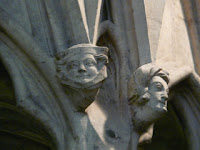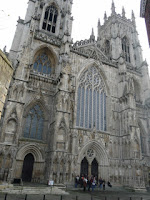Some of this history is nicely tucked away in other historical sites. And some of it lurks underneath other buildings of historical interest. For example, forty years ago they realized that the York Minster was in the process of collapsing. This was because, while it had been expanded over the centuries, no-one had thought to expand the foundations to cope with the ever increasing load… The comforting thought here is that bureaucratic oversights are not merely a modern phenomena.
When they realized this (the foundation problem, not the modern bureaucratic oversight issue), and sank £2M into fixing the problem they got a side bonus. Underneath the cathedral were some of the remains of two previous cathedrals (Norman and Saxon, in descending order of depth underground). And the real find, the remains of a Roman Principia were also uncovered. All lying under the cathedral.

So, once we had spent almost two hours inside the cathedral, we then spent another hour under the Cathedral. (sans camera, I’m afraid—no pictures allowed. So please enjoy some more pictures of the Cathedral itself instead.) We got to look at the stone work from the Norman Cathedral, and then the Saxon Cathedral. Even some of the stained glass had survived. The most amazing piece was some blue glass that no-one can work out how it was made—the process has been lost. Which is a bit of a shame, the glass was over millennia old and was still an amazingly deep and bright blue. My laptop screen starts going dull two years in…
We also got to see the inside of a Roman building, with some of the fresco still surviving—it had fallen face down off its wall and so had (mostly) survived. It was a picture of a Mediterranean countryside. So it was like the B.C. version of a landscape painting, (or screen saver) but on a much bigger scale, giving the inhabitants a bit of an illusion that they were back home enjoying the wide open spaces. It could rain and sleet outside and they could imagine, in their toasty warm building, painted in warm Mediterranean colours, that they were enjoying sunny Italy.

Also on display underground were some of the large collection of cups, plates, archbishop paraphernalia (rings etc) all made out of precious and semi-precious material. If it hadn’t been after the architecture lurking under the present day Minster it would have been very impressive. As it was, it was ok, but its thunder had not just been stolen, it had been sold at the local pawnshop. (On another note, it’s probably the Protestant in me, but for all I appreciate the beauty, I wish the church hadn’t seen the need to tie up so much wealth in the medieval equivalent of an executive boardroom.)
The amusing bit in how they organized this tour of the foundations was that they left it until the end to show you the actual pillars holding the building up and to tell you the ridiculous number of kilotons they were supporting. More than one person seemed to move fairly quickly above ground once that had been brought to their attention…

Still, it was a cathedral. Why wouldn’t you expect multiple layers of history underneath? Isn’t that what cathedrals are for after all, to preserve history?
Well, how about the local pub? Pubs aren’t really known as great historical treasurehouses. That’s not really the essence of pubs in most people’s minds I think it’s safe to say. York had several pubs, all of them fairly nondescript (from a historical point of view, they all seemed wonderfully atmospheric from a pub point of view). None of them were really worth mentioning from a historical perspective. They were all a few centuries old, which meant they had been around longer than any building in Australia, so hardly worth mentioning really.

Yet, one of these nondescript pubs turns out to have an unusual basement. They discovered one end of the Roman baths under it just recently. So you can go under this pub and check out a small section of York’s Roman bath from around two millennia ago. And then you could have lunch there (the pub, not the bath).

Being in the construction industry in York, or a plumber, must be potentially a whole different experience with every job you do. Pick goes down, ground moved, ah, we’ve found another… Saxon fortification… Norman hall… Roman storehouse… (take your pick). It looked like they were doing some digging near a local corner store. Maybe we should go back next year to take a tour of what they find underneath that. MDB

2 comments:
"Take your pick" - ha, nice pun.
I kept reading, hoping to find Harrison Ford leap out and do something unexpected, but there you go. Not a film reference, really, I guess?
"Pick goes down...(take your pick)" -- groan. I assume that that was unintentional. :-)
Post a Comment